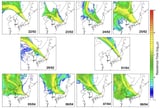Airborne Microbes: Study Reveals Pathogens Surviving at 10,000 Feet Over Japan
September 10, 2024
Researchers from the Barcelona Institute for Global Health conducted flights to collect air samples, discovering that bacteria and fungi can travel over 1,200 miles and reach altitudes of about 10,000 feet.
A recent study published in the Proceedings of the National Academy of Sciences reveals that a variety of microbial species, including human pathogens, are surviving in the upper troposphere over Japan.
Among the identified pathogens were strains of E. coli and Bacillus cereus, with the latter showing high resistance to antibiotics like penicillin and ampicillin.
Lead researcher Xavier Rodó noted that approximately 30-40% of the microbes collected could potentially cause diseases in humans.
While the concentration of these microbes is low, raising direct transmission concerns, the introduction of these pathogens into new environments poses significant risks.
The study highlights the potential for the spread of antimicrobial resistance genes through airborne microbes, which could threaten public health.
Despite not establishing a direct causal link between airborne pathogens and disease outbreaks, the research emphasizes the need for further exploration of how these microbes could impact human health.
The study confirms that microorganisms can be transported by wind over long distances and have developed protective mechanisms against environmental factors.
Rodó's interest in the research was partly driven by epidemiological links between Kawasaki disease surges in Japan and winds originating from agricultural regions in northeast China.
Chemical analyses indicated that dust particles collected during the study originated from agricultural areas in China, suggesting a link between farming practices and microbial transport.
Biofilms formed by these microorganisms can shield them from harmful ultraviolet radiation and desiccation, allowing them to survive their journey through the atmosphere.
Rodó cautions that while the findings are concerning, they do not imply that all airborne microbes are harmful or that future pandemics will originate from the sky.
Summary based on 8 sources
Get a daily email with more World News stories
Sources

The New York Times • Sep 9, 2024
10,000 Feet Up, Scientists Found Hundreds of Airborne Germs
The Guardian • Sep 9, 2024
Pathogenic microbes blown vast distances by winds, scientists discover
Popular Science • Sep 11, 2024
The sky is full of germs
Phys.org • Sep 10, 2024
Researchers find live fungi, bacteria and viruses high in the Earth's atmosphere